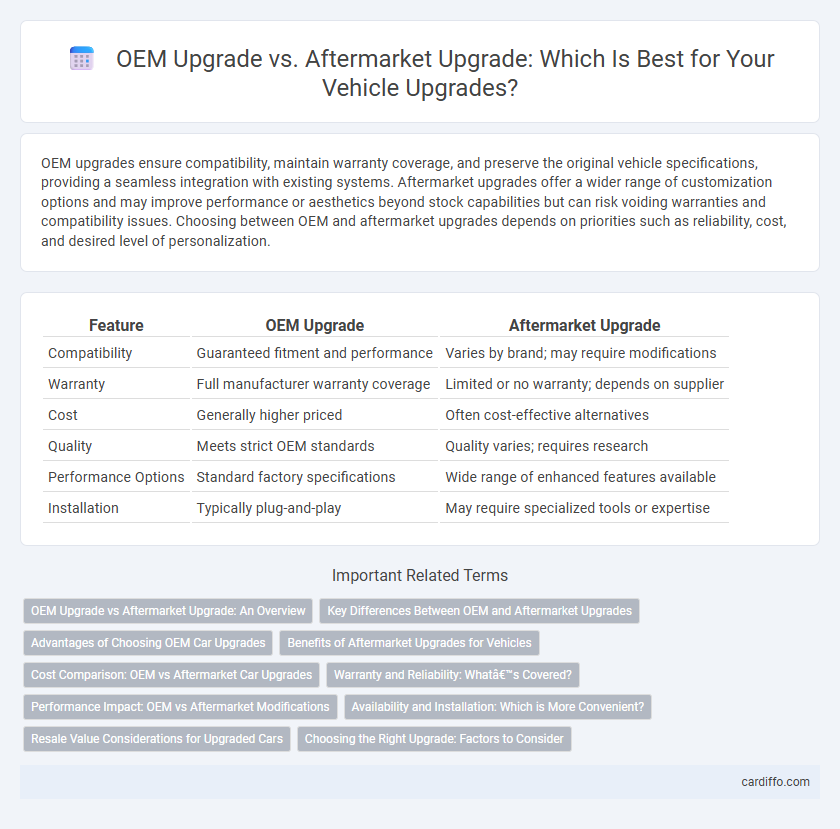OEM upgrades ensure compatibility, maintain warranty coverage, and preserve the original vehicle specifications, providing a seamless integration with existing systems. Aftermarket upgrades offer a wider range of customization options and may improve performance or aesthetics beyond stock capabilities but can risk voiding warranties and compatibility issues. Choosing between OEM and aftermarket upgrades depends on priorities such as reliability, cost, and desired level of personalization.
Table of Comparison
| Feature | OEM Upgrade | Aftermarket Upgrade |
|---|---|---|
| Compatibility | Guaranteed fitment and performance | Varies by brand; may require modifications |
| Warranty | Full manufacturer warranty coverage | Limited or no warranty; depends on supplier |
| Cost | Generally higher priced | Often cost-effective alternatives |
| Quality | Meets strict OEM standards | Quality varies; requires research |
| Performance Options | Standard factory specifications | Wide range of enhanced features available |
| Installation | Typically plug-and-play | May require specialized tools or expertise |
OEM Upgrade vs Aftermarket Upgrade: An Overview
OEM upgrades ensure compatibility and maintain warranty coverage by using manufacturer-approved parts specifically designed for the original system. Aftermarket upgrades offer more customization options and often lower costs but may pose risks like reduced reliability and potential warranty voidance. Choosing between OEM and aftermarket upgrades depends on balancing quality assurance with budget and customization needs.
Key Differences Between OEM and Aftermarket Upgrades
OEM upgrades provide components designed and tested by the original manufacturer, ensuring full compatibility and warranty protection. Aftermarket upgrades offer a wider variety of options that may improve performance or aesthetics but can vary in quality and may void warranties. Choosing between OEM and aftermarket upgrades depends on priorities like reliability, cost, and customization potential.
Advantages of Choosing OEM Car Upgrades
OEM car upgrades guarantee compatibility and maintain factory warranty coverage, ensuring long-term reliability and performance. These upgrades are rigorously tested to meet strict quality and safety standards set by the vehicle manufacturer. Choosing OEM parts also preserves vehicle resale value by providing documented authenticity and original equipment conformity.
Benefits of Aftermarket Upgrades for Vehicles
Aftermarket upgrades offer significant benefits for vehicles, including enhanced performance, improved fuel efficiency, and increased customization options not typically available through OEM upgrades. These upgrades provide access to a wider range of innovative parts and technologies, often at more competitive prices, allowing for tailored modifications that meet specific driver preferences and requirements. Moreover, aftermarket upgrades can extend a vehicle's lifespan and resale value by addressing wear and enhancing overall functionality beyond factory specifications.
Cost Comparison: OEM vs Aftermarket Car Upgrades
OEM upgrades typically command higher prices due to brand assurance, precise fit, and warranty coverage, making them a premium investment for vehicle enhancement. Aftermarket upgrades offer a cost-effective alternative with a broader range of options, though they may vary in quality and compatibility, potentially impacting long-term value. Evaluating total ownership costs, including installation, durability, and potential resale value, is crucial for an informed decision between OEM and aftermarket car upgrades.
Warranty and Reliability: What’s Covered?
OEM upgrades usually come with manufacturer-backed warranties that ensure full coverage for parts and labor, maintaining the original reliability standards set by the vehicle maker. Aftermarket upgrades often have limited warranties that may not cover all components or repair costs, potentially impacting the overall vehicle warranty. Choosing OEM upgrades helps preserve factory reliability assurances and reduces the risk of voiding important warranty protections.
Performance Impact: OEM vs Aftermarket Modifications
OEM upgrades are designed to maintain manufacturer specifications, ensuring optimal engine performance and reliability without compromising warranty coverage. Aftermarket modifications often aim to boost power and torque beyond stock limits but can introduce risks such as reduced engine lifespan or drivability issues if not properly tuned. Performance gains from aftermarket parts vary widely, with some achieving significant horsepower increases, while OEM upgrades provide consistent, manufacturer-backed improvements.
Availability and Installation: Which is More Convenient?
OEM upgrades offer guaranteed compatibility and easier installation due to precise fitment and manufacturer support, ensuring minimal modifications and faster integration. Aftermarket upgrades provide greater availability with a wider range of options, but often require additional adjustments and professional expertise during installation. Choosing between OEM and aftermarket depends on balancing convenience against customization preferences and component accessibility.
Resale Value Considerations for Upgraded Cars
OEM upgrades maintain vehicle warranty and ensure compatibility with original components, preserving the car's resale value more effectively. Aftermarket upgrades might offer enhanced performance or aesthetics but can raise concerns about reliability and insurance, potentially reducing buyer appeal. Resale value considerations favor OEM upgrades due to verified quality and manufacturer support, making them a safer investment for cars intended for future sale.
Choosing the Right Upgrade: Factors to Consider
Choosing the right upgrade requires evaluating compatibility, warranty implications, and quality standards between OEM and aftermarket options. OEM upgrades ensure original manufacturer specifications and seamless integration, while aftermarket upgrades often offer cost savings and customization flexibility. Consider performance goals, budget constraints, and long-term reliability to make an informed decision aligned with your specific needs.
OEM upgrade vs aftermarket upgrade Infographic

 cardiffo.com
cardiffo.com